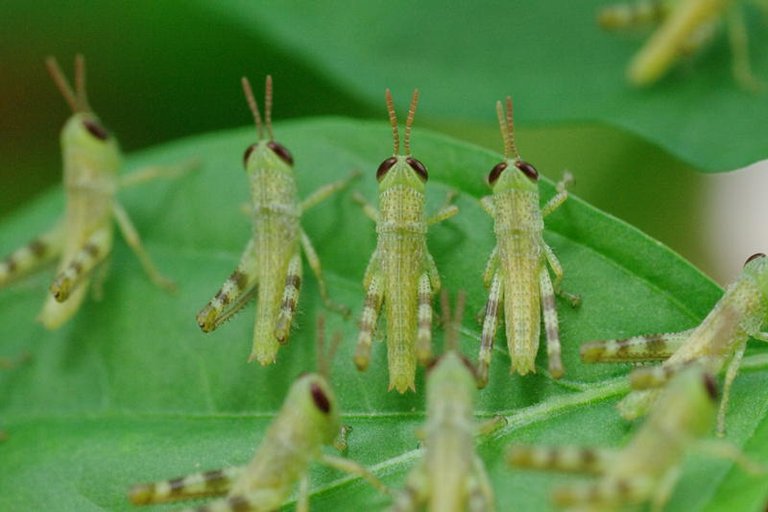Science Explained : What Are Locusts From Grasshoppers
Grasshoppers and Locust! I have a feeling that you are one of those who are confused what they both mean. Are grasshoppers, locust or are Locust, grasshoppers? Or maybe they are no where related to one another in any way. So let me do you thee honors of breaking this down to you quickly and simply like a 3 year old with a genius brain.
In the world, there are more than 12,000 species of grasshoppers and while almost all of them remain grasshoppers all through their lives, less than 20 species can become locusts and if you want to understand, we call grasshoppers 'Locust' in their swarming phase. On a regular day, the single grasshopper remains what it is because it isn't following the crowd. At least it isn't only humans that has the crowd mentality, some species of grasshopper do as well.
Among the less than 20 species are the Egyptian Locust (Anacridium aegyptium), Central American Locust (Schistocerca piceifrons), Schistocerca cancellata, Australian Plague Locust (Chortoicetes terminifera), Rocky Mountain Locust (Melanoplus spretus), Desert Locust (Schistocerca gregaria) and so on. When the conditions are right they begin swarming season where they come from different breeding areas in a regions flying in groups up to 70 billion in a swarm and they feed up to their weight of vegetation daily and which is the reason for the name plague when this event occurs.
Except for Antarctica, locust are found in all continents and they wreak havoc on plants especially broad leave grassy plants which make our staple food. Out of the species of locusts that wreak havoc, the species in North America, the Rocky Mountain Locust (Melanoplus spretus) were the worse of them as they damage a lot of plants but became extinct in the 1800s.
When I mentioned the right condition, a good example of such would be the Desert Locust. These grasshopper would grow in very little population, scattered around the deserts in Africa and india but they would not come together to form a locust because the condition of the desert isn't favorable to allow them grow so many with lack of grasses and plenty of arid land but when there is an abundant of rain in the desert, thee ground becomes wet and vegetation begin to grow. It is in this condition that the grasshoppers reproduces a lot and there are lots of nymphs which hatch at almost the same time. Because the area starts to become dry again, the nymphs can begin to come together instead of spreading out and they become locusts.
If they had gone in different directions, they would be grasshoppers but because they are together, they become locust. Because the sight and smell of other grasshoppers around them, they begin to have behavioral changes which leads them to begin a feeding spree everywhere they can find food. As they touch themselves physically, their serotonin level is increased thereby affecting their mood.
These touches also produce physical changes compared to grasshoppers that didn't have any physical touch. If a grasshopper with no physical touch from other grasshoppers and a locusts with physical touch from other grasshoppers which are now locust are viewed, they will have different physical appearances even though they have the same DNA. This is as a result of Phenotypic plasticity which is as a result of how the DNA instructions in them interact with the environment they find themselves.
If we want to look at grasshoppers and locust, we can say that when there is lean to eat, grasshoppers are born but when the condition is right and all things are suitable, locusts are produced. So what makes a locust and a grasshopper is favourable condition especially enough food to eat so enable mating and large number of offspring.
Reference
https://www.undrr.org/understanding-disaster-risk/terminology/hips/bi0003
https://www.cell.com/current-biology/fulltext/S0960-9822
https://www.nationalgeographic.com/animals/article/gigantic-locust-swarms-hit-east-africa
https://www.hcn.org/issues/issue-243/the-death-of-the-super-hopper/
https://www.livescience.com/locusts.html
https://entomologytoday.org/2019/09/04/swarm-shift-how-locusts-switch-phases-when-numbers-swell/
https://www.nature.com/articles/s41598-017-07105-y
https://www.health.harvard.edu/mind-and-mood/serotonin-the-natural-mood-booster
https://bioone.org/journals/journal-of-orthoptera-research/volume-14
https://www.fao.org/ag/locusts/oldsite/LOCFAQ.htm#q10
https://www.genome.gov/genetics-glossary/genotype
https://www.cell.com/current-biology/fulltext/S0960-9822
https://www.nationalgeographic.com/animals/article/gigantic-locust-swarms-hit-east-africa
https://www.hcn.org/issues/issue-243/the-death-of-the-super-hopper/
https://www.livescience.com/locusts.html
https://entomologytoday.org/2019/09/04/swarm-shift-how-locusts-switch-phases-when-numbers-swell/
https://www.nature.com/articles/s41598-017-07105-y
https://www.health.harvard.edu/mind-and-mood/serotonin-the-natural-mood-booster
https://bioone.org/journals/journal-of-orthoptera-research/volume-14
https://www.fao.org/ag/locusts/oldsite/LOCFAQ.htm#q10
https://www.genome.gov/genetics-glossary/genotype


Congratulations @ireti! You have completed the following achievement on the Hive blockchain And have been rewarded with New badge(s)
Your next target is to reach 85000 upvotes.
You can view your badges on your board and compare yourself to others in the Ranking
If you no longer want to receive notifications, reply to this comment with the word
STOPThanks for your contribution to the STEMsocial community. Feel free to join us on discord to get to know the rest of us!
Please consider delegating to the @stemsocial account (85% of the curation rewards are returned).
Thanks for including @stemsocial as a beneficiary, which gives you stronger support.